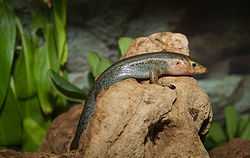Bermuda rock skink
| Bermuda skink | |
|---|---|
 | |
| Conservation status | |
| Scientific classification | |
| Kingdom: | Animalia |
| Phylum: | Chordata |
| Class: | Reptilia |
| Order: | Squamata |
| Family: | Scincidae |
| Genus: | Plestiodon |
| Species: | P. longirostris |
| Binomial name | |
| Plestiodon longirostris Cope, 1861 | |
The Bermuda skink or rock lizard (Plestiodon longirostris, formerly Eumeces longirostris[1][2]) is the only endemic terrestrial vertebrate of the Bermudas (ignoring marine turtles and the terrapins found in brackish ponds [3]). It is a relatively large skink (a kind of lizard): adults reach an average snout-to-vent length of about 8 cm (a bit more than 3 inches).
Description
Adult Bermuda skinks (also known locally as "rock lizards") have dark brown or black backs and are pinkish or light gray on the underside. Juveniles are lighter in color and have black stripes running along the sides of their bodies, which fade with age. Females retain the stripes longer than males. Adult males have larger heads. Hatchlings have bright blue tails. All have salmon orange cheeks and throat.
The Bermuda skink lives predominantly in rocky coastal areas. They feed on small invertebrates such as crickets or beetles, but also on small terrestrial crustaceans.
While being more active during summer, the Bermuda skink does not hibernate, because the warm climate allows it to be active year-round.
Distribution and Conservation Status
The species occurs wild only in Bermuda, and exists mainly on some of the smaller islands and one nature reserve on the mainland where the populations are fragmented into isolated pockets.
The Bermuda skink has been listed on the IUCN Red List as critically endangered. It is threatened primarily by habitat destruction, predators introduced by humans (such as cats or rats), as well as by human litter: the Bermuda skink has tiny claws on its feet, but no friction pads, and when it gets trapped in a cast-away empty glass bottle or soda can, it cannot climb out and thus starves or dies of heat stress or dehydration.
The Bermuda skink is listed as protected under the 2003 Bermuda Protected Species Act.
Chester Zoo is attempting to increase numbers of the skink with its own captive breeding program.[4]
References
- Conyers & Wingate (1996). Eumeces longirostris. 2006. IUCN Red List of Threatened Species. IUCN 2006. www.iucnredlist.org. Retrieved on 11 May 2006. Database entry includes justification for why this species is critically endangered
- ↑ Brandley M.C., Schmitz A., Reeder T.W. (2005). "Partitioned Bayesian analyses, partition choice, and the phylogenetic relationships of scincid lizards." Systematic Biology 54 (3): 373–390. doi:10.1080/10635150590946808
- ↑ Smith, H.M. (2005). "Plestiodon: a replacement name for most members of the genus Eumeces in North America." Journal of Kansas Herpetology 14: 15–16.
- ↑ Bermuda Aquarium, Museum & Zoo: Diamondback Terrapin Project
- ↑ UK zoo creates a skink to save rare lizards (retrieved 11 August 2013)
External links
- Bermuda Aquarium, Museum & Zoo: Bermuda Skink Project
- IUCN Red List entry
- Bermuda Department of Conservation Services page on Bermuda Skink
